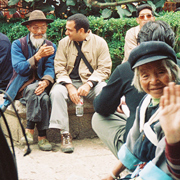
The four aspects pattern identification
The four aspects are used to determine the origin and development of externally contracted febrile diseases. This system was divised by Ye Tian Shi (1667-1746) in his book Discussion of Warm Diseases and it describes the pathological changes caused by exterior Wind-heat. The four aspects used in the identification and treatment of warm disease patterns are: defensive, Qi, construction (nutritive), and blood.
Ye Tian-shi states
The general conception is that Qi comes after defense and that blood comes after construction. When disease affects defense, sweating can be administered. Only when the disease reaches the Qi aspect can Qi-clearing treatment be prescribed. When it enters construction, treatment involves outthrusting heat to the Qi aspect. Finally, when the disease reaches blood and causes depletion and frenetic movement, treatment involves cooling and dissipating the blood.
Identification of patterns according to the Three Burners (Sanjiao theory)
This system was devised by Wu Ju Tong (1756-1836) in his book A Systematic Identification of Febrile Diseases. This method of identification of patterns is usually combined with the four aspects method for diagnosing and treating febrile infectious diseases caused by invasion of wind-heat.
The patterns of the three burners are:
Upper burner
Wind-heat invading the lungs – this patterns is the same as the defense aspect of the four aspects pattern identification.
Heat in the lungs – corresponds to the Qi aspect of the four aspects pattern identification.
Heat in the pericardium – corresponds to the construction aspect of the four aspects pattern identification.
Middle burner
Heat in the Yangming – the patterns are the same as the Organ pattern identification for
the Large intestine and the Stomach. It is also the same as the
Yangming level of the Six channel pattern identification.
Damp-heat invading the spleen
Lower burner
Various damp to damp-heat patters which are usually identified under Organ pattern identification.
REFERENCES
A. Ellis, N. Wiseman, K, Boss Fundamental s of Chinese Acupuncture, 1991, Paradigm Publications, Brookline Massachusetts
C. Zinnong (Chief Editor) Chinese Acupuncture and Moxibustion, 1987, Foreign Language Press, Beijing
G. Maciocia The Foundations of Chinese Medicine, 1996, Churchill Livingstone, New York
T J Kaptchuk Chinese Medicine – The Web Has No Weaver, 1989, Rider, London


